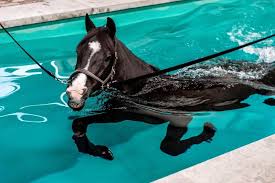Yes, horses can really swim, thanks to their large lungs and instinctive leg movements that resemble trotting. This natural ability helps them stay buoyant and navigate water efficiently, which is crucial for survival and herd safety. Swimming also offers horses low-impact exercise that enhances cardiovascular fitness and muscle strength. While strenuous, it’s a skill rooted in their evolution. Exploring further, you’ll discover the detailed mechanics, benefits, and safety aspects behind this surprising talent in horses.
Table of Contents
- The Natural Swimming Ability of Horses
- How Horses Swim: Mechanics and Technique
- Survival Benefits of Swimming in the Wild
- Health and Fitness Advantages of Swimming for Horses
- Training and Safety Considerations for Swimming Horses
- Frequently Asked Questions
The Natural Swimming Ability of Horses
Although horses are primarily known for their speed and agility on land, they possess a natural ability to swim that plays an important role in their survival.
Horses have a natural instinct to swim, supported by their large lungs, which hold about 14.5 gallons of air. This lung capacity helps horses float and breathe easily while in water. Swimming is one of the key abilities horses use to escape danger and cross rivers. Their fitness levels allow them to swim steadily, maintaining momentum despite the strenuous effort it demands, making swimming a crucial skill for freedom in their natural environment.
How Horses Swim: Mechanics and Technique
When horses swim, they use a paddle-like motion with their legs that closely resembles the trotting movement seen on land. This swimming technique supports buoyancy and forward momentum, relying heavily on the horse’s lung capacity to keep its head above water.
Understanding how horses swim involves recognizing that:
- Their large lungs hold up to 14.5 gallons of air, aiding buoyancy.
- The motion is physically demanding, comparable to a 3-mile gallop.
- Their significant muscle mass powers efficient, rhythmic strokes.
This combination allows horses to swim effectively, though it requires considerable endurance and control.
Survival Benefits of Swimming in the Wild

Swimming plays a vital role in the survival of horses in the wild. When horses swim, they rely on instinct to navigate deep water, often necessary to reach safety or richer grazing grounds.
This skill supports herd movement, enabling groups of horses to cross rivers together while escaping predators. Swimming also maintains the physical fitness essential for endurance during these crossings, helping horses thrive in unpredictable environments.
Health and Fitness Advantages of Swimming for Horses
Swimming engages a large portion of a horse’s muscles, offering significant health and fitness advantages beyond land-based exercises.
As horses work against water resistance, their cardiovascular fitness improves without joint strain. Swimming benefits horses by:
- Enhancing muscle flexibility and endurance
- Providing low-impact conditioning to prevent tendon injuries
- Improving heart and respiratory efficiency
Regular swimming can elevate overall health and performance, making it a valuable addition to a horse’s fitness routine.
Training and Safety Considerations for Swimming Horses
Proper training and safety measures are essential to secure a positive swimming experience for horses.
Introduce your horse gradually, starting in shallow water where they can touch the bottom. Use positive reinforcement to build confidence without stress.
Always monitor for fatigue, avoid sudden depth changes, and ensure both horse and rider are prepared. Respecting the horse’s natural abilities and physical limits ensures safer, more effective swimming sessions.
Frequently Asked Questions
Can a Horse Actually Swim?
Yes, horses swim naturally using leg paddling and their buoyancy aided by large lung capacity and body structure.
Can a Horse Carry a 300LB Rider?
Yes, larger breeds like draft horses can carry heavy riders, though training and physical conditioning are essential for safety.
How Long Can Horses Swim For?
Horses can swim for 20–30 minutes depending on endurance and training. Gradual sessions build stamina and improve performance.
Are Horses Really Good Swimmers?
Yes, horses are effective swimmers due to their lung capacity, muscle strength, and paddling technique. Some breeds excel more, but all benefit from proper training.
Conclusion
Understanding how horses swim highlights their remarkable adaptability and resilience. Swimming is not only a natural survival skill but also an excellent form of fitness for horses, promoting strength, endurance, and confidence. With careful training and safety measures, your horse can enjoy the many benefits of this aquatic exercise safely and effectively.





